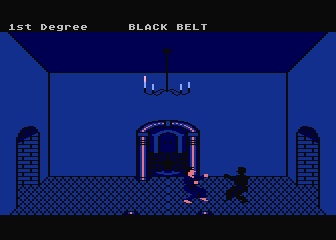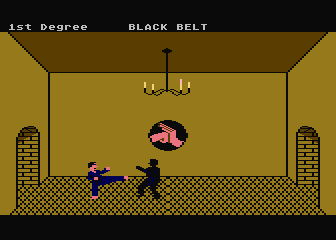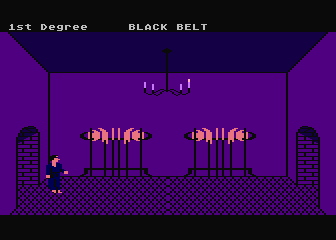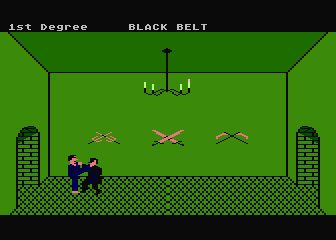|
|
Black Belt
|
Name:
|
Black Belt |
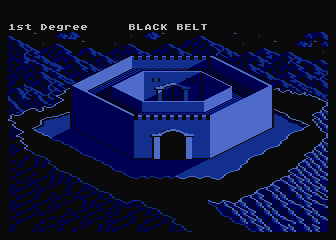 |
| Company: | Atari | |
|
Model #:
|
CX-5231 | |
|
Programmers:
|
Alan Moss Sr. (Programmer &
Additional Graphics) & Alan Murphy (Graphics) |
|
| Year: | 1983 | |
|
Released?
|
No
|
|
|
Notes:
|
Originally called "Martial Arts" |
Long before there was Karateka, there was Black Belt. Black Belt was Atari's entry into the martial arts genre at a time when such games were almost unheard of. Black Belt is a multi-screened action game with amazing visuals and easy to understand controls. Had it been released, Black Belt would have been the first one-on-one fighting game and a solid entry into the 5200 library.
After the normal 5200 splash screen, players are treated to an amazing pseudo 3-D picture of the temple complex This temple is very reminiscent of the opening castle in Meebzork and shows off the 5200's graphics capabilities nicely. Players may now pick their black belt degree (from 1st to 8th degree) using the number pad. The black belt degree serves as the difficulty level for the game, which affects how fast the ninjas move. Starting the game is a bit tricky as you must press start then the 0 key. It is unknown why the 0 key must be pressed, but it serves as the reset button for the rest of the game.
After starting the game, the screen switches to a side view of a room in the temple interior. The temple complex is made up of six beautifully drawn rooms. Each room has its own decor and color scheme with no two rooms looking the same. After you enter a room you'll eventually be confronted by one of the temple's ninjas which appear as all black figures. It is unknown if this is because they are only placeholder graphics, or if they were simply meant to be dressed in all black (as ninjas are known to be). If you look closely you'll see that the ninjas have inverse colors from the main character (except for the skin) and actually have a dark blue highlights.
Black Belt's controls are pretty intuitive. The joystick moves your character around the room, the number keys (1-9) are used to select different karate moves, and the button will turn your character around to face the opposite direction. Each move is different and it is assumed that the ninjas would have blocked them accordingly. Unfortunately the only known version of Black Belt is incomplete and lacks collision detection so the player and ninjas cannot hurt each other. This means that the game is largely unplayable and there is no way to complete a level.
|
Key
|
Move
|
Picture
|
|
1
|
High Punch
|
 |
|
2
|
High Block
|
 |
|
3
|
High Kick
|
 |
|
4
|
Middle Punch
|
 |
|
5
|
Middle Block
|
 |
|
6
|
Middle Kick
|
 |
|
7
|
Low Punch (left)
|
 |
|
8
|
Low Block
|
 |
|
9
|
Back Kick
|
 |
Besides the lack of collision detection, Black Belt seems to have a few other problems that hamper the gameplay. For one thing your character seems to move very very slow (perhaps he's creeping around the complex), and unlike Karateka there doesn't seem to be a run option. There also seems to be no way to open or move through the doors that occasionally appear in the background. It is unknown if these doors were actually supposed to lead to other rooms or if they were just decoration, but an Atari memo does mention an 'external scene'. Interestingly your character can move through the doorway at the bottom of the first screen which will take you back to the view of the outside of the temple.
Programmer Alan Moss was a Karate expert and used his knowledge of martial arts to make Black Belt as realistic as possible. According to graphics artist Alan Murphy, Alan Moss even adjusted some of the graphics to make them match real Karate moves.
"Alan Moss was a Karate expert and modified some of the animations that I started. So they were “pixel perfect”. At the time, I didn’t know much about martial arts so he took the animations that I started and pushed a few pixels to more closely match various karate blows, kicks, blocks etc. by modifying the base animation."
Despite looking like a fighting game, in a brief interview Alan did for the CED Q2 1983 In-house video (a video which showed other employees what each programmer was working on), he mentioned that the game was based on true martial arts philosophy and that the player was meant to avoid confrontation where possible. The video also mentions that the game was supposed to have a dynamic difficulty where it adjusted itself according to the skill of the player. Oddly the video also hints at a possible two player cooperation mode ("players cooperate to win"), but it is unknown how this would have been implemented and it is not mentioned anywhere in other internal documents.
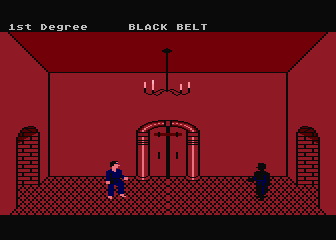
It is hoped that a more complete version of Black Belt exists because this early prototype (believed to be from around 1/6/83) shows a lot of promise. Internal documents show that the game was falling behind schedule (it was due to be completed on 3/15/83) and around this time the programmer then left Atari. It appears that either no one was available to finish the game or that Atari decided to cancel the project. Even in its incomplete form, Black Belt shows what the 5200 could do if properly programmed. Why didn't we see more original games like this?
Black Belt Map
| Version | Cart Text | Description |
| 7/5/83 | Blk Blt 7-5-83 | Very early version |
| 12/23/82 | Early WIP | |
| 1/6/83 | Black Belt |
Mid Level WIP |

